Waves in Matter (OCR)
Waves transfer energy without transferring matter from a point to another.
When light waves pass from a phone to your eye, only energy is being transferred.
In water waves, it's the wave that travels and not water itself.
**Direction of propagation:** direction in which the wave is moving or traveling.
Mechanical Waves:
Need a medium to travel from one point to another.
Can't travel in vacuum.
E.g. sound waves, sea waves, seismic waves, waves in a rope or spring.
All of these require a medium to travel. Sound cannot travel without air, sea waves cannot travel without water.
Electromagnetic waves:
Don't need a medium to travel.
Can travel in vacuum and through a medium too.
E.g. gamma and X-rays, UV rays, visible light, infrared, microwaves, radio waves.
TYPES OF WAVE MOTION
Transverse waves:
The direction of vibration (of the source or the medium's particles) is at right angles to the direction of wave motion.
High points are called crests, and the low points are troughs.
E.g. EM waves, water waves, waves in a rope, seismic S-waves.
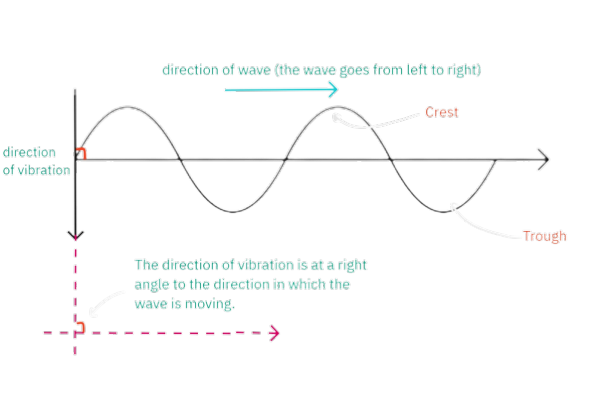
Longitudinal waves:
The direction of vibration (of the source or the medium's particles) is parallel to the direction of wave motion.
E.g. sound.
Particles of the source move back and forth along the same line in which the wave is traveling.
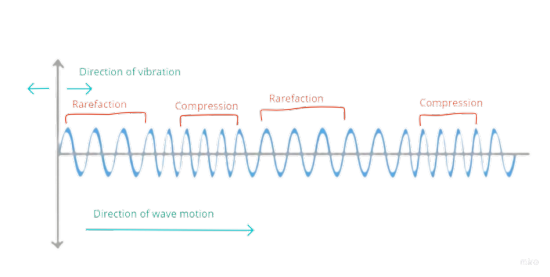
Compression and rarefaction:
Compression: particles are closest together (high pressure zone).
Rarefaction: particles are farthest apart (low pressure zone).
Particles do not move along with the wave, they only oscillate up and down their individual positions.
Animations in this link will help understand this:
https://www.acs.psu.edu/drussell/demos/waves/wavemotion.html
FEATURES OF A WAVE
Amplitude (A):
The height of a crest or the depth of a trough is amplitude.
The maximum displacement of a point on a wave from its mean position.
The maximum and minimum points of amplitude are same, there's only difference of signs, e.g. +8 and -8.
Measured in meters (m).
Larger the amplitude, the more the wave's energy.
Time period (T):
Time taken to produce one complete wave/oscillation.
Frequency (f):
The number of waves passing a point per second (or produced per second) is frequency.
Measured in Hertz (Hz).
Frequency = 1/T, where T is the time period.
Higher the frequency of a wave, smaller its wavelength.
Wavelength (λ):
The length of one complete wave is wavelength.
It's also the distance between two **consecutive** crests or troughs.
Wave speed (v):
The distance traveled by a waveform per unit time.
Wave speed = wavelength x frequency.
Measured in m/s.
Phase:
Two points are in phase if they have the same displacement and motion throughout the wave motion.
Points 1 wavelength apart are always in phase.
In this displacement-distance graph, points B and D have the same motion and displacement, so they are in phase. A and C are in phase too for the same reason. They have the same **speed** in the same **direction**. Points B and D are not in phase with points A and C, however, because their directions of vibration are opposite.
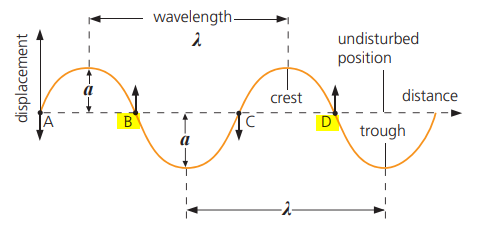
Wavefront:
An imaginary line that joins all crests or troughs of waves travelling parallel to one another.
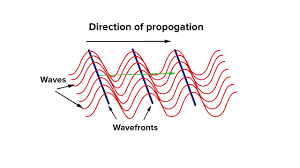
Reflection at a plane surface:
Reflection: the change in direction of a wave as it collides with an obstacle.
During reflection, frequency, wave speed and wavelength don't change.
The amplitude decreases after reflection due to loss of energy.
Larger the amplitude, more the wave's energy.
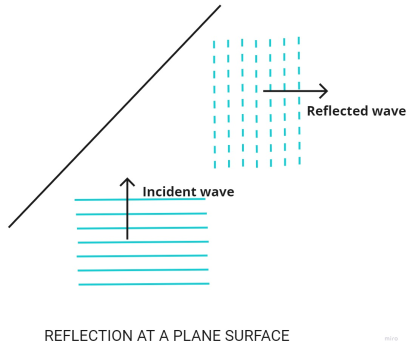
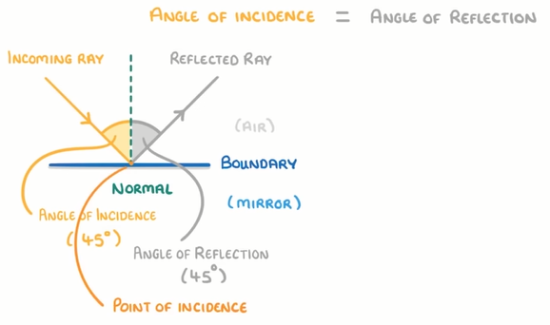
Refraction:
Refraction is the change in wave speed and wavelength as the wave travels from a medium to another, or from one depth to another.
For electromagnetic waves, refraction is when the EM waves slow down or speed up due to the change in medium of the wave in which it travels.
For water waves, when a wave travels from deep to shallow water, the wave speed and wavelength decrease.
Depth decreases, so wavelength decreases and so does the wave speed and vice versa.
Wavelength and wave speed are directly proportional.
If the change in depth is perpendicular to the direction of approaching waves, wavelength and wave speed will change and not direction.
If the depth of water is changed at an angle, the direction of the waves also changes along with the speed.
Unless the source of vibration changes, the frequency remains unchanged.
Snell's Law: n1sinθ1=n2sinθ2n_1 \sin \theta_1 = n_2 \sin \theta_2n1sinθ1=n2sinθ2
n is the refractive index.
θ is the angle of incidence/refraction.
Applications: Lenses, prisms.
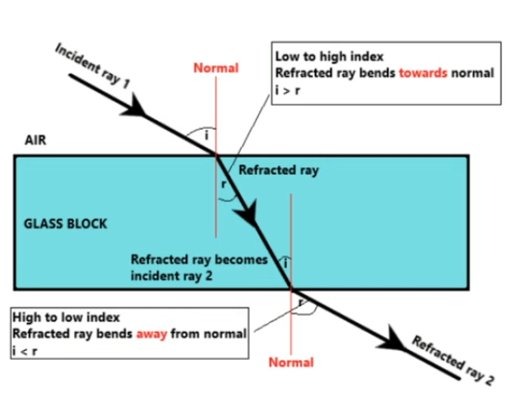
Diffraction:
When waves meet a barrier, they pass through the gap and spread out.
The spreading of waves at the edges of obstacles is diffraction.
The way the waves diffract depends upon how big the gap is.
The wave spreads out more if the gap is made narrower or if the wavelength is increased.
It spreads out less with a wider gap or a shorter wavelength.
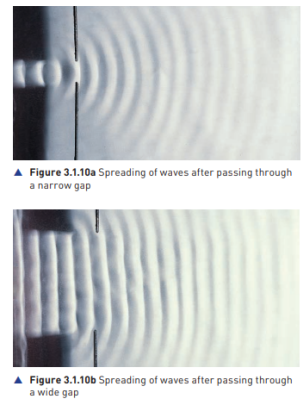
Electromagnetic Spectrum
EM waves form when electric and magnetic fields interact
Gamma rays have the highest frequency, hence are the most energetic and dangerous (energy is directly proportional to frequency)
EM waves are transverse, can travel in vacuum, and have the same speed in it i.e 3.0x10^8 m/s
The obey the laws of reflection and refraction
Can be emitted and absorbed by matter
Can transfer energy
Light is a **part** of the EM spectrum and not the EM spectrum itself

Uses and Dangers of EM spectrum
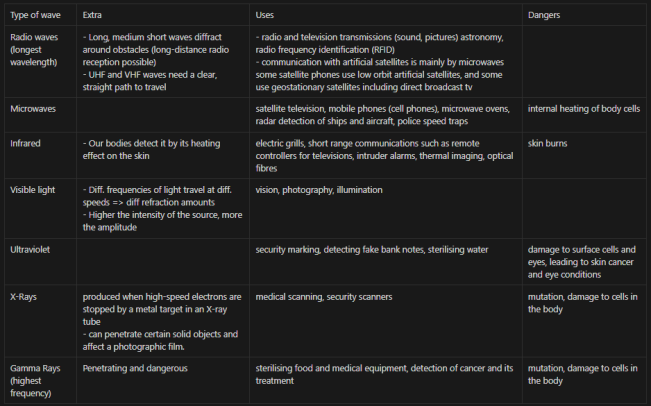
Sound waves
Type: Longitudinal mechanical waves.
Oscillations: Particles of the medium oscillate parallel to the direction of wave propagation.
Medium Requirement: Sound waves require a medium (solid, liquid, or gas) to travel. They cannot propagate through a vacuum.
Factors Affecting Speed
Medium:
Solids: Sound travels fastest in solids because particles are closely packed and can transmit vibrations more efficiently.
Liquids: Sound travels faster in liquids than in gasses but slower than in solids.
Gasses: Sound travels slowest in gasses due to larger intermolecular spaces.
Temperature:
Higher temperatures increase the speed of sound in gasses because particles move faster and transmit vibrations more quickly.
Formula: Approximate speed of sound in air v=331+0.6Tv = 331 + 0.6Tv=331+0.6T (T in °C)
Typical Values
Air: Approximately 343 m/s at 20°C.
Water: Approximately 1500 m/s.
Steel: Approximately 5000 m/s
Interference
Constructive Interference: When two sound waves meet in phase, resulting in a louder sound.
Destructive Interference: When two sound waves meet out of phase, resulting in a quieter sound or silence.
Applications: Noise-canceling headphones, acoustics design
Human Hearing Frequency Range
Audible Range: Approximately 20 Hz to 20 kHz.
Infrasound: Frequencies below 20 Hz (e.g., earthquakes, large machinery).
Ultrasound: Frequencies above 20 kHz (e.g., medical imaging, dog whistles).